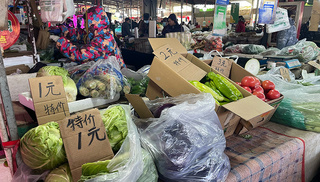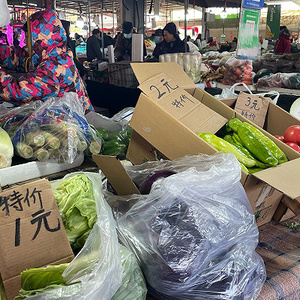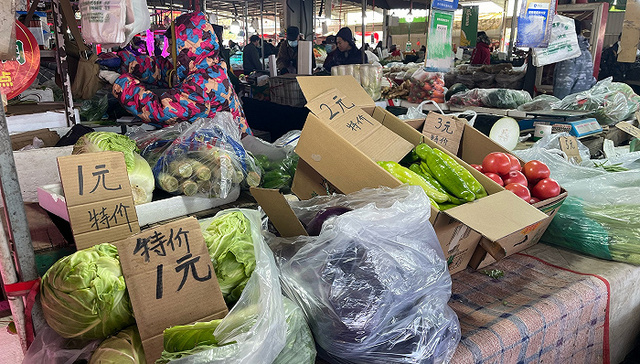By WU Bingcong
In the heartland of Shouguang, Shandong, a paradox unfolds against a picturesque landscape. ZHU Tingting, a local villager, embarks on a 10-kilometer journey from her home to a sprawling vegetable field. Here, she and her friends load their car with abandoned radishes.
"This hill covers 70 to 80 acres. Many villagers come here to salvage vegetables, but the farmers are facing heavy losses," Zhu said.
Rotting in the fields
Not far from Shouguang, SHI Yingfei, drives off in a refrigerated truck bound for Xinfadi, one the biggest agricultural markets in China, on the outskirts of Beijing. His cargo, celery and cauliflower. Shi shuttles back and forth every three or four days, but this year, vegetable prices and transport costs are low. “We're not making much profit," Shi says.

Shandong proudly holds its position as the leading vegetable producer among the nation's 31 provinces. From field to market, a grim tale unfolds.
At Xinfadi, cabbage hits a historic low at 0.25 yuan per jin (half a kilo), and the story echoes in the Yangtze River Delta, where cabbage and bok choy cling to prices around 0.3 yuan per jin. The situation is dire – quality compromised, and prices further slashed by an additional five fen (0.05 yuan).
As winter envelopes the country, an unsettling calm befalls the vegetable market. Unharvested fields in Shandong, Hebei, Inner Mongolia, and beyond are laden with Chinese cabbage, celery, radishes, and green onions, left to rot. What leads to such a paradox, where abundance coexists with neglect, and why do vegetable prices plummet even as winter tightens its grip?
Know your onions
In the frigid expanses of Inner Mongolia, WANG Pengfei tends to 2,000 acres of yellow potatoes. He paints a bleak picture of local vegetable sales, where potatoes, once sold for 1,800 yuan per ton in the field, have dwindled to approximately 1,300 yuan after storage. With additional costs factored in, each ton incurs an 800 yuan loss, plunging many farmers into the depths of financial despair.
"Green onions sell for two fen per jin, and some farmers have resorted to turning over their fields," Wang sighs.
Social media narratives reveal a poignant reality – from Shandong to Hebei, Inner Mongolia, and beyond, vegetables like Chinese cabbage, celery, radishes, and green onions are offered at meager prices, and in some instances, abandoned in fields with no takers.
Yet, the plight extends beyond supply-demand dynamics and climatic uncertainties. The consumption environment, a silent arbiter of market trends, plays a role. During economic upswings, supermarkets and restaurants catalyze robust vegetable sales, fostering inflation.
Zucchini and despondency
As traditional vegetable production areas face challenges, competition intensifies, even among small-scale farmers. At the Luhai Agricultural Trade Market in Beijing, Chinese cabbage fetches a mere 1 yuan from Xinfadi, where local farmers are offering their produce for a mere 0.5 yuan. With no logistics or market fees, these local farmers present an even more economical option.
Yet, amid the despondency, a few regions stand resilient. Luffa and zucchini from Guangdong and Yunnan find a niche, maintaining stability.
As December begins and temperatures fall, hope emerges. Beijing, relying on winter storage vegetables, greenhouse produce from the north, and vegetables transported from Hainan and Yunnan, anticipates a surge in prices. Tong Wei anticipates that increased transportation costs during winter will shift the market from field vegetables to greenhouse produce, ultimately leading to a price hike.
In this tapestry of struggles, one must ponder the fate of the farmers. Even if vegetable prices rise, the plight remains for those at the grassroots. LI Lixing, from Xia Yi, Henan, reveals a painful reality – tens of thousands of kilograms of chili peppers await sale in his shed. After accounting for labor costs, farmers are left with a 1 to 2 fen per jin. White cabbage and celery present an even more somber picture, with farmers netting only a few cents.
More than supply and demand
As China grapples with the paradox of plenty, where abundance converges with destitution, the intricate web of factors influencing vegetable prices unveils a complex narrative.
The hardship faced by farmers, the dynamics of supply and demand, and the oscillations of the economy collectively paint a poignant picture of the challenges within China's agricultural heartland.





